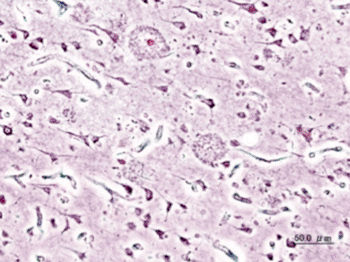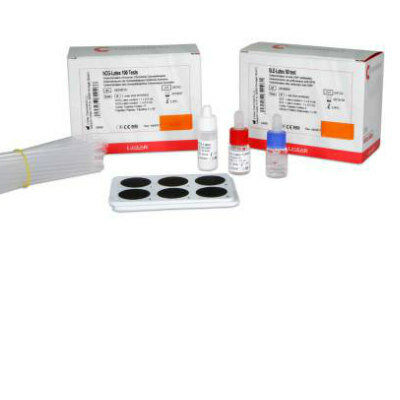Loss of Sialidase Activity Linked to Alzheimer's Disease in Mouse Model
By LabMedica International staff writers
Posted on 16 Dec 2013
Loss of sialidase enzyme activity in the brain was linked in a recent study to the formation of toxic amyloid plaques such as those found in the brains of Alzheimer's disease patients.Posted on 16 Dec 2013
The protein encoded by the NEU1 (sialidase or neuraminidase) gene is a lysosomal enzyme that cleaves terminal sialic acid residues from substrates such as glycoproteins and glycolipids. In the lysosome, this enzyme is part of a heterotrimeric complex together with beta-galactosidase and cathepsin A (the latter is also referred to as "protective protein"). Mutations in the NEU1 gene can lead to sialidosis, a lysosomal storage disease of infants and children.

Image: Silver impregnation histopathogic image of amyloid plaques seen in the cerebral cortex of a patient with Alzheimer disease (Photo courtesy of Wikimedia Commons).
Investigators at St. Jude Children’s Research Hospital (Memphis, TN, USA) worked with a line of mice that they had genetically engineered to lack the NEU1 gene. Results published in the November 14, 2013, online edition of the journal Nature Communications revealed that loss of NEU1 activity was associated with a lysosomal build-up of amyloid precursor protein (APP). Improperly processed APP was fragmented into the toxic peptides that form Alzheimer’s amyloid-beta plaques. Those fragments included amyloid-beta peptide 42 (Abeta-42), which is thought to play a major role in the Alzheimer’s disease process. Indeed, Abeta-42 was detected in the spinal fluid and hippocampus of mice that lacked NEU1, but not in mice with a functional NEU1 gene.
Some of the mice lacking the NEU1 gene and displaying Alzheimer's disease-like symptoms were treated by gene therapy that used a viral vector to reestablish NEU1 activity. The amount of beta-amyloid plaques was substantially reduced in the treated animals.
“The findings suggest that down-regulation of NEU1 and a reduced supply of the enzyme may contribute to the development of Alzheimer’s disease or similar neurodegenerative disorders in some patients,” said senior author Dr. Alessandra d’Azzo, professor of genetics at St. Jude Children’s Research Hospital. “Among the questions we are asking is whether a therapeutic window exists when the enzyme could be used to halt or even reverse the disease.”
Related Links:
St. Jude Children’s Research Hospital














